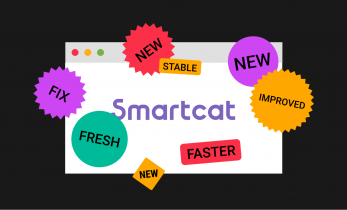Greater than 7 minutes, my friend!
Smart devices and the future of CAT tools
CAT tools have already been on the market for many years now and yet they are still improving. New technologies and emerging needs from translators are triggering a shift from computer-aided translation tools to smart device-aided translations tools. Does the future of productivity lie in web-based translation environments?
The emergence of online translation environments
While CAT tools nowadays are inevitable in the toolkit of translators, it is still not long ago that professional translators had to work without them. The tools for computer-aided translation, not to be confused with online translation tools like Google Translate, only emerged in the early 1990s. Although there might have been some earlier attempts to create software that helps translators to improve their quality, productivity and consistency, in the last decade of the last century they came into full swing. Nowadays translators can choose from at least 20 different CAT tools, both online and offline, to suit their needs out of which SDL Trados and MemoQ are by far the best known.
However, only 25 years after the introduction of mainstream translation software a new era is on the horizon. The introduction of cloud technology, the rise of digital nomads, and the general availability of cheap and fast internet connections has led to a new branch on the CAT tool tree: translators can now use online translation environments, both free and paid, to work wherever they choose to.

The login screen of Smartling
Translating online
The technological advancements in the last couple of years opened great opportunities for companies who looked beyond traditional CAT tools and wanted to pluck the low-hanging fruit of the cloud’s capabilities. Several professionals, both from inside and outside the translation industry, quickly introduced their own online variants of the desktop translation tools. Examples included Smartling and Memsource (which has a desktop tool as well). These tools are browser-based, which means that they are accessible as webpages and can be used to work wherever users want as long as they have a compatible device and an internet connection. The online translation environments offer full functionality, which is often equivalent to the standard desktop tools. Users (in the case of Smartling and Memsource mainly project managers) can create translation memories and term bases, set rules for quality assurance and require users to perform several checks before they can deliver their translations. The tools also offer support for the most common file formats, like Microsoft Office files, PDF files and HTML documents, but also for bilingual filetypes like XLIFF and the proprietary formats of Trados and MemoQ. In addition, they often have familiar user interfaces, with well-known toolbars and panels that make it easier for project managers and translators alike to find their way in the online CAT tool.
It might be clear that the new members in the CAT tool family are working disruptively to shake up the CAT tool industry. It is therefore not a surprise that after the introduction of new online CAT tools developers of ‘traditional’ CAT tools also came up with an online version. MemoQ introduced MemoQ Web while SDL brought SDL Online Translation Editor to the table.

Online translation environment in MemoQ Web
Web-based CAT tools for translators
The most important feature of the web-based CAT tools is, (how surprising), that they work in a browser. Most of them were initially designed to work on a desktop, offering translators a convenient tool with omnipresent accessibility while at the same time making it easier for project managers to dispense projects. Indeed, project managers only had to upload files, create or connect a translation memory, and send a link to multiple translators, making it easier to complete projects, shorten the turnaround time, and circumvent lengthy discussions via email. But because these new online CAT tools were mainly directed at agencies and project managers, they fell short of meeting the needs of translators who wanted to work on the go. Other bright minds therefore developed new web-based CAT tools that supported the needs of the freelance translator better: in the past few years Lilt and Smartcat were introduced, among others. The SDL Online Translation Editor has also been created with freelance professionals in mind, while MemoQ Web is more dedicated to project managers.
The biggest difference between tools for freelance translators and project managers is their workflow. While project managers have loads of options to manage projects, tools like Lilt and Smartcat introduce only the options freelancers need: they can upload a file in different file types, create or use a translation memory (term bases are often not supported), work their way through the file, and complete the job. The tools have a familiar and simple user interface, so translators do not need to look for advanced options, but often, powerful options are hidden under the bonnet, so they can really compete with their desktop equivalents.
Another major advantage of CAT tools in the cloud is that they frequently release new features quickly and respond to feature requests even faster, while traditional CAT tools often require months for implementing, testing, and introducing new features in a newly built (minor) version of their tool.
Another major difference is that many tools aimed at freelancers are free to use. They offer various plans for advanced users, often based on the amount of characters being translated, but there is only one free flavour, and it comes without many of the options that paid users have access to.
The interface of Smartcat
Privacy concerns with online CAT environments
In the past few years the online CAT tools have quickly risen to the level at which they can compete with traditional computer-based CAT tools. Where CAT tools have evolved and added new features with every new release, their online counterparts were introduced according to the status quo of traditional CAT tools. They sometimes even introduced ground-breaking new features that traditional CAT tools were not able to offer, like Lilt’s adaptive machine translation.
Yet among translators there is still much debate about their adaptations. The most important concern is that of privacy. While computer resources are generally considered a safe option, many translators are afraid to use cloud environments because of the risk of hacks and leaks that expose clients’ confidential information. At the same time, using a free online translation environment sometimes requires that translations are shared with the platform provider to improve the quality of generally available translation memories and machine translation services. Freelancers, whose business depends on credibility, simply cannot afford to share their client’s information for the sake of improving their productivity or flexibility.
On the other hand, early adopters and technology enthusiasts debate that the cloud is much safer than many computers thanks to continuous security updates. However, they are only a small group in the world of translators.
From CAT to SAT?
Whatever the privacy concerns, until now the introduction of online CAT tools has made clear that they are here to stay. With the increasing adaptation of online tools, lifestyles shifting to working on the go, and digital nomadism it is expected that online translation environments will be increasingly in demand in the future.
Although traditional CAT tools do not offer any opportunities to be run on smart devices with an Android, iOS, or Windows Phone operating system, online CAT tools do not have this problem. That means that they can be used without barriers on smartphones and tablets, once they have been adopted on a computer. Indeed they offer the same experience everywhere as they are browser-based and do not need to be adapted much to work in different operating environments. An added advantage of this possibility is that users can start a task on their desktop, then work on it while away, and complete it in a third environment.
Yet, despite the seemingly endless possibilities of the online CAT tools, many of them still do not offer a flawless experience on smartphones and tablets. One of the biggest disadvantages of the browser-based tools is that they do not fit neatly onto the small screens of smart devices. A short experiment with a few translation platforms (Smartcat and Lilt; SDL’s Online Translator Editor returned an error) quickly showed that the user interface has problems with touch-enabled devices. While all elements of a CAT tool (the panel with the bilingual format, a panel with translation memory results, a concordance panel, and some other interface elements) are present, they often do not fit neatly. While the interface appears fine in its initial state, touching a text box to add a translation will cause the panels to be re-arranged every time. Furthermore after touching the screen the screen keyboard pops up, often making (a part of) the source text invisible. While this problem is apparent on tablets, it is even more problematic on smartphones with even smaller screens. Working on a translation on the go using a tablet of smartphone therefore does not offer a seamless, flawless, or productive experience just yet.
Another problem is that rendering the translation environment on a tablet or smartphone requires considerable computing resources on some devices. So in order to make full use of an online CAT tool, users need to have a powerful tablet or smartphone that can execute scripts and render style sheets quickly to realize a productivity gain.

Problematic view of a CAT tool on a tablet

Lilt with opened screen keyboard
That brings us to the question of whether online CAT tools can fulfil the needs of professional translators. Basically, the answer is yes. Online CAT tools often work well on desktops. However, they are currently an online variant on computer-aided translation tools. That does not mean that they are fully fledged to become smart device-based translation tools (SAT). The current generation of browser-based CAT tools is perfect to use with laptops while one is on the go, but in order to benefit from their full potential for smartphones and tablets they still need to be more adapted to these devices. The future of CAT tools is in our hands, but it still need to be adapted to our fingers.






Thank you for this thorough overview!
I used to be skeptical on the emergence of cloud-based software at the expense of CATs… until I found myself using my CAT tool barely once a week and spend the rest of the time on such platforms. I’m sure adequate interfaces for tablets and smartphones will be developed soon, it’s the obvious next step 🙂 For me, at the moment it’s enough to be able to switch from my desktop to my laptop without having to physically transfer files, if a project is in progress and any day I decide to leave the house and work from elsewhere.